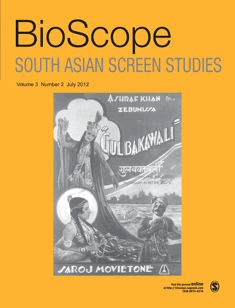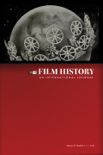
Journal of African Cinemas
Scope & Guideline
Exploring the Rich Tapestry of African Film Narratives
Introduction
Aims and Scopes
- Cultural Representation and Identity:
The journal focuses on how African cinema represents cultural identities, narratives, and experiences, examining the interplay between film and societal issues such as colonialism, nationalism, and gender. - Historical Contextualization:
It emphasizes the historical development of African cinema, tracing its evolution from early filmmaking to contemporary practices, and how these reflect broader societal changes. - Critical Film Analysis:
The journal provides critical analyses of films, exploring themes such as representation, genre, and cinematic techniques, contributing to a deeper understanding of the artistic and technical aspects of African cinema. - Transnational Perspectives:
A significant aspect of the journal is its focus on transnational cinema, examining how African films engage with global narratives and aesthetics while maintaining local relevance. - Film Festivals and Industry Dynamics:
The journal also addresses the role of film festivals, market dynamics, and the evolving landscape of film production and distribution within Africa.
Trending and Emerging
- Intersectionality in Cinema:
Recent publications increasingly explore intersectional themes, particularly how race, gender, and class intersect in cinematic narratives, reflecting a broader societal shift towards inclusivity and representation. - Documentary and Participatory Cinema:
There is a growing focus on documentary filmmaking and participatory cinema, emphasizing how these forms can empower communities and provide platforms for marginalized voices. - Digital Media and New Platforms:
The rise of digital media and streaming platforms has become a significant theme, exploring how these developments are reshaping the production, distribution, and consumption of African films. - Critical Engagement with Film Festivals:
An emerging trend is the critical examination of film festivals as spaces for cultural exchange and dialogue, particularly focusing on their role in shaping narratives and showcasing diverse African voices. - Queer Cinema and LGBTQ+ Representation:
There is a marked increase in the exploration of queer cinema and LGBTQ+ representation in African films, indicating a shift towards more inclusive storytelling and recognition of diverse sexual identities.
Declining or Waning
- Early Cinema History:
While early cinema in Africa has been addressed, recent publications indicate a waning interest in this area, possibly due to a shift towards more contemporary issues and narratives in African cinema. - Traditional Gender Roles:
There has been a noticeable decrease in discussions specifically centered on traditional gender roles in cinema, as the focus has shifted towards more nuanced explorations of gender and sexuality in contemporary contexts. - Static Cultural Narratives:
The journal has seen less emphasis on static cultural narratives that do not engage with evolving societal issues, reflecting a broader trend towards dynamic and intersectional analyses. - Censorship Discussions:
Discussions surrounding censorship in African cinema, while still relevant, have become less frequent, indicating a potential shift towards more proactive engagement with representation and autonomy in filmmaking. - Local vs. Global Tensions:
The tension between local and global narratives, although still significant, appears to be less emphasized, suggesting a movement towards integrating these discussions within broader themes of transnational cinema.
Similar Journals

Hrvatski Filmski Ljetopis
Analyzing the Rich Tapestry of Croatian Cinema.Hrvatski Filmski Ljetopis, published by the Croatian Film Clubs Association, serves as a pivotal academic journal in the field of film studies, celebrating and analyzing the rich cinematic heritage of Croatia and beyond. With an ISSN of 1330-7665, this journal caters to researchers, practitioners, and students who are passionate about the art of filmmaking, encompassing both theoretical discourse and practical implications. Although it is not currently available as an open-access publication, its curated content is of significant value to anyone interested in the evolution, critique, and history of film in a Croatian context, having previously been indexed in Scopus until coverage was discontinued. The journal operates out of Zagreb, Croatia, at the Croatian Film Clubs Association headquarters, and aims to foster scholarly dialogue while contributing to the broader field of national and international cinematography.

Bioscope-South Asian Screen Studies
Illuminating the Rich Tapestry of South Asian CinemaBioscope-South Asian Screen Studies is an influential journal dedicated to advancing the field of screen studies in the South Asian context, published by SAGE Publications India Pvt Ltd. With an ISSN of 0974-9276 and an E-ISSN of 0976-352X, this journal spans a convergence of scholarly research from 2010 to 2024, providing a significant platform for interdisciplinary dialogue. Holding a Q3 rating in Communication and a Q2 rating in Visual Arts and Performing Arts in the 2023 category quartiles, it ranks 212th in its field on Scopus, reflecting its vital contribution to academic discourse. Bioscope aims to explore and critically analyze the rich tapestry of South Asian cinema, media, and performance arts, offering researchers, professionals, and students a valuable resource for deepening their understanding of regional and global cinematic narratives. Readers will find insightful articles that probe the cultural, social, and political dimensions of screen studies, making this journal an essential reference for anyone engaged in the evolving landscape of South Asian visual culture.

Film History
Illuminating cinema's past to inspire future narratives.Film History, published by Indiana University Press, is a premier academic journal that delves into the evolving landscape of cinema, illuminating the intricate interplay between historical narratives and film culture. With ISSN 0892-2160, and E-ISSN 1553-3905, this journal has established itself as a crucial resource for researchers, professionals, and students in the fields of history and visual arts. Recognized in the Q2 category for both History and Visual Arts and Performing Arts as of 2023, it boasts impressive Scopus rankings, securing #152 out of 667 in Visual Arts and Performing Arts, and #524 out of 1760 in History, placing it in the top 30th percentile. Although it does not currently offer open access options, the journal provides a wealth of scholarly articles that critically engage with film as a historical text, fostering a deeper understanding of its role in shaping societal narratives. Since its inception in 1987, Film History has been at the forefront of academic discourse, making it an invaluable resource for those seeking to explore the rich tapestry of cinematic history.

CANADIAN REVIEW OF AMERICAN STUDIES
Fostering Scholarly Dialogue Across BordersCanadian Review of American Studies, published by University of Toronto Press Inc, stands as a vital scholarly outlet in the fields of American studies, literature, cultural studies, and history. With its origins tracing back to 1973, this journal provides a platform for innovative research and critical discourse, appealing to a wide audience of researchers, professionals, and students alike. While currently indexed in Scopus with quartile rankings highlighting its position in various categories—Q4 in Cultural Studies, History, and Literature and Literary Theory—the journal embraces a robust pursuit of knowledge that examines the intricate layers of American culture and its global intersections. Although it does not offer open access, the journal's commitment to academic rigor ensures its contributions are indispensable for understanding the complex narratives that shape American identity. As it continuously evolves, the Canadian Review of American Studies serves as an essential resource for anyone engaged in this dynamic and interdisciplinary field.

Japan Review
Cultivating Insight into Japan's Cultural and Historical LandscapeJapan Review, published by the International Research Center for Japanese Studies, is an esteemed academic journal that serves as a significant platform for exploring a diverse array of topics related to Japan within the fields of Arts and Humanities and Social Sciences. With an ISSN of 0915-0986 and an E-ISSN of 2434-3129, this journal endeavors to enrich scholarly discourse from 2019 to 2023, encompassing interdisciplinary studies that shed light on cultural, historical, and societal aspects of Japan. Though not an open-access journal, it is recognized for its contributions to the academic community, evidenced by its ranking in the Q3 quartile in Arts and Humanities and Q4 in Social Sciences. Its Scopus rankings indicate its growing influence, with a 36th percentile rank in the arts category, making it a valuable resource for researchers, professionals, and students aiming to deepen their understanding of Japanese studies. The journal's commitment to promoting high-quality research underlines its crucial role in advancing knowledge within its field.

Canadian Journal of Film Studies-Revue Canadienne d Etudes Cinematographiques
Innovating Critical Discourse in Film StudiesCanadian Journal of Film Studies-Revue Canadienne d'Études Cinématographiques is a distinguished publication dedicated to the exploration of film studies within the context of Canadian cinema and global visual arts. Published by University of Toronto Press Inc., this journal offers a platform for innovative and critical scholarship, having achieved a notable Q2 ranking in the Visual Arts and Performing Arts category for 2023, with an impressive Scopus rank of 207 out of 667, positioning it in the 68th percentile among peers. With a continuous publication record since its established years from 1998 to 2001 and 2004 to 2024, it has become an essential resource for researchers, professionals, and students interested in the evolving landscape of film and cinema. The journal not only addresses theoretical perspectives but also engages with contemporary practices, thereby fostering a deeper understanding of cinematic arts. Despite not offering open access, it remains a vital repository of knowledge for those seeking to advance their studies and contribute to the discourse in film studies.

Journal of British Cinema and Television
Exploring the Rich Tapestry of British Screen CultureJournal of British Cinema and Television, published by Edinburgh University Press, is a leading academic journal that explores the dynamic interplay between British cinema and television within the context of cultural studies. With an ISSN of 1743-4521 and E-ISSN of 1755-1714, this journal provides a platform for scholarly discourse, enabling researchers, professionals, and students to engage with critical analyses of screen media and its socio-political impact. As a Q3 journal in Communication and a Q1 journal in Visual Arts and Performing Arts for 2023, it occupies an influential position, particularly in the Arts and Humanities, where it ranks in the 90th percentile. The journal's scope encompasses a wide range of topics, from historical perspectives to contemporary practices in British visual culture, making it essential reading for anyone interested in the evolution and significance of screen studies in the UK. While it is not an open-access publication, the rigorous peer-review process ensures high academic standards and contributes to its esteemed reputation in the field. As it continues to converge from 2004 to 2024, the Journal of British Cinema and Television remains a vital resource for those seeking to deepen their understanding of British media and its global resonance.

SIGHT AND SOUND
Engaging Minds Through the Lens of FilmSIGHT AND SOUND is a prestigious journal published by the British Film Institute, dedicated to the exploration of cinema and its cultural significance. With an ISSN of 0037-4806 and an E-ISSN matching the same, this journal has been a critical platform for film studies since its inception, contributing valuable insights to the realms of visual arts and performing arts. Despite its discontinuation in the Scopus database post-2021, SIGHT AND SOUND commands respect within its field, currently holding a Q3 rank among Visual Arts and Performing Arts journals. Operating from 21 Stephen Street, London W1P 1PL, England, it serves as a vital resource for researchers, professionals, and students looking to deepen their understanding of film theory, critique, and history. While access to its articles is not open, the journal continues to influence the discourse in film studies, making it a significant asset in academic and professional circles.

Etica & Cine
Advancing Critical Discourse in Visual CultureEtica & Cine is a distinguished open-access journal published by the University of Buenos Aires, Faculty of Psychology, dedicated to the interdisciplinary field of ethics in cinema and visual culture. With the ISSN 2250-5660 and E-ISSN 2250-5415, this journal has been a vital platform for researchers, professionals, and students since its inception in 2011, providing a space for critical discourse surrounding the ethical dimensions of film and media. The journal aims to foster scholarly dialogue by publishing high-quality articles that explore the philosophical, social, and psychological implications of filmic representations. While the journal's H-index is yet to be established, its commitment to open access ensures that valuable insights are readily available to a global audience, thus enhancing its significance in academic and professional circles. As the conversation around ethics in cinema continues to evolve, Etica & Cine stands as an essential resource for anyone engaged in this vital area of study.

FILM QUARTERLY
Unveiling Insights in Film StudiesFilm Quarterly, published by University of California Press, stands as a leading academic journal in the field of visual arts and performing arts, boasting a prestigious Q1 ranking in the 2023 category quartiles. Since its inception in 1969, this quarterly publication has made significant contributions to the study and critique of cinema, attracting attention for its insightful articles, cutting-edge research, and comprehensive reviews that appeal to scholars, practitioners, and students alike. With an ISSN of 0015-1386 and an E-ISSN of 1533-8630, it serves as an essential resource for those seeking to enhance their understanding of film theory, history, and analysis. Although not open access, its articles are critical for researchers navigating the complex landscape of contemporary and historical film studies, underscoring its vital role in advancing scholarship within the discipline.